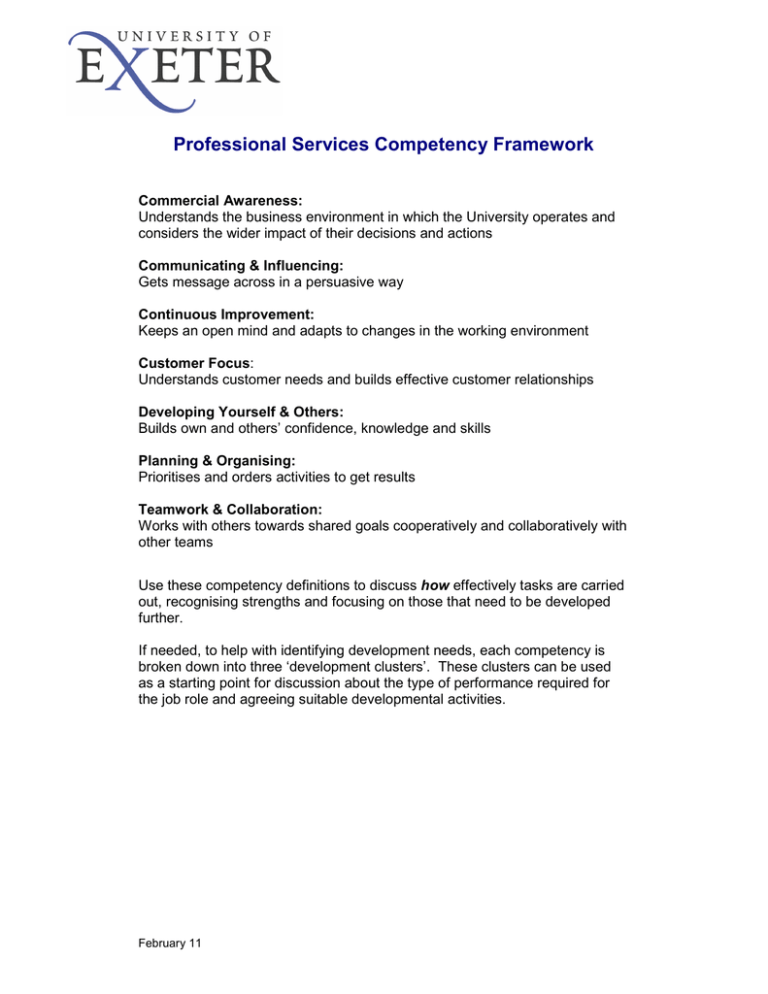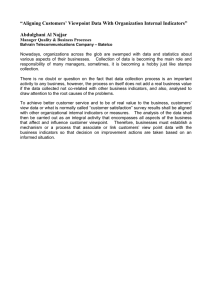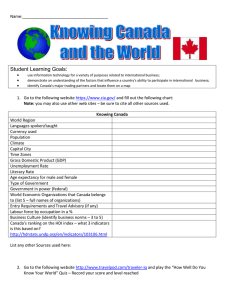Professional Services Competency Framework
advertisement

Professional Services Competency Framework Commercial Awareness: Understands the business environment in which the University operates and considers the wider impact of their decisions and actions Communicating & Influencing: Gets message across in a persuasive way Continuous Improvement: Keeps an open mind and adapts to changes in the working environment Customer Focus: Understands customer needs and builds effective customer relationships Developing Yourself & Others: Builds own and others’ confidence, knowledge and skills Planning & Organising: Prioritises and orders activities to get results Teamwork & Collaboration: Works with others towards shared goals cooperatively and collaboratively with other teams Use these competency definitions to discuss how effectively tasks are carried out, recognising strengths and focusing on those that need to be developed further. If needed, to help with identifying development needs, each competency is broken down into three ‘development clusters’. These clusters can be used as a starting point for discussion about the type of performance required for the job role and agreeing suitable developmental activities. February 11 Commercial Awareness Understands the business environment in which the University operates and considers the wider impact of their decisions and actions Development Clusters Core Indicators: + Understands the contribution their role makes to the success of the business + Understands the needs for the business to generate increased income and understands how their team can support this + Questions actions where appropriate and identifies more cost-effective approaches + Meets the expectations of customers without compromising budgets Mid Level Indicators: + Puts forward sound business case to gain support for new and more effective methods of working + Prioritises actions to minimise costs and maximise advantage across the organisation + Understands the need to demonstrate a return on investment in activities and identifies opportunities for generating income + Looks beyond immediate problems/issues to see the impact on the bigger picture + Actively pursues alternative ideas and ways of working to gain cost savings + Uses financial information to find pragmatic new ways of saving cost/effort without reducing throughput Strategic Level Indicators: + Takes a balanced view of wider impact on the organisation when making significant changes + Anticipates changes in the HE marketplace when budgeting for the future + Develops commercial strategy which delivers consistent improvement in output, quality and cost reduction 1 Communicating and Influencing Gets message across in a persuasive way Development Clusters Core Indicators: + Clear when they communicate + Constructive and positive in what they have to say + Involved at meetings, asks questions, listens and gives information when appropriate Mid Level Indicators: + Tailors their style and content to suit the situation or person + Builds relationships based on trust + Uses data and facts in a clear and constructive way to support arguments and gain agreement + Prepares strong and influential business case, understanding the needs of all stakeholders + Appreciates the impact of decisions on others and mitigates any negative effects Strategic Level Indicators: + Clarifies the vision and goals for every team member + Uses communication to create a shared sense of purpose and direction + Demonstrates effective networking skills to maintain a broad range of trusted contacts throughout the University + Develops strategies which ensure win-win solutions for all parties + Achieves widely accepted ‘buy in’ by explaining benefits at both individual and department level 2 Continuous Improvement Keeps an open mind and adapts to changes in the working environment Development Clusters Core Indicators + Invites regular feedback on performance from team members and customers + Quickly turns new ideas into clear and effective improvements + Looks for better ways of doing things and suggests improvements + Shares their ideas with colleagues and seeks support from management in developing those ideas Mid Level Indicators + If they have responsibility for others, encourages and supports staff to make suggestions for improvement + Sets standards for quality and ensures best practice if they have responsibility for doing so + Integrates systems and processes to avoid duplication of effort + Shows an awareness of how changes might impact differently on different stakeholders Strategic Level Indicators + Communicates and manages the need for change + Leads the implementation of changes with a positive approach + Creates a culture where new ideas are encouraged and evaluated; obstacles removed and resources are used in the most effective way in order to achieve University goals + Capitalises on opportunities to improve processes, systems or efficiency 3 Customer Focus Understands customer* needs and builds effective customer relationships Development Clusters Core Indicators: + Demonstrates common courtesy even when customer is difficult or demanding + Responds promptly to customer requests and whenever possible within agreed timeframes + Assesses customer needs accurately by listening /sensitive questioning + Keeps promises made to customers + Shows awareness of who their customers are Mid Level Indicators: + Consistently strives to provide a quality service + Manages expectations so customers always feels valued + Actively seeks feedback and suggestions to improve customer service + Champions customer service improvement initiatives Strategic Level Indicators: + Anticipates customer’s future needs and identifies their key strategic issues + Creates a culture of professionalism in dealing with customers at all levels + Creates mutually supportive and loyal relationships with all major customers + Sees the wider picture, understands the levels of service that are valued by customers and ensures that these are the priority at all times + Understands and applies sector-wide standards *Customers can be internal or external, staff or students 4 Developing Yourself & Others Builds own and others’ confidence, knowledge and skills Development Clusters Core Indicators: + Identifies what learning and development they need to do their job effectively + Is flexible and willing to adapt and learn + Participates fully in reviews and in agreed SMART development objectives + Seeks and responds positively to feedback regarding their learning and development Mid Level Indicators: + Uses appropriate development approaches to suit the needs of each team member + Evaluates the effectiveness of training in the development of their team + Creates a supportive coaching culture and shares their knowledge and skills Strategic Level Indicators: + Integrates people development in their business plans + Matches long term business needs with the career development and job fulfilment of staff + Creates an environment which encourages continuous learning and development + Develops the whole business through learning and development 5 Planning & Organising Prioritises and orders activities to get results Development Clusters Core Indicators: + Overcomes obstacles to ensure work gets done on time + Prioritises workload to meet important objectives + Motivates and encourages people to achieve planned results + If appropriate to role, manages team effectively, delegating work to use resources to best effect + Informs colleagues of changes in priorities and helps them to plan their workload + Monitors progress and puts effort in where it is most needed Mid Level Indicators: + Plans effectively for the medium and long term, reviewing strategies and revising to meet changing business needs + Organises resources to successfully achieve both short and medium term objectives + Liaises effectively with colleagues outside of immediate team to coordinate activities + Develops effective systems to organise and track workload + Confidently juggles complex projects of different size and priority Strategic Level Indicators: + Sets a clear sense of direction, forward thinking and responsibly shapes the future + Empowers individuals and passes decision making down to the lowest appropriate level + Produces a consistent, ‘no blame’ culture, with a feeling of pride and achievement 6 Teamwork & Collaboration Works with others towards shared goals cooperatively and collaboratively with other teams. Development Clusters Core Indicators: + Actively participates within the team + Helps others within the team, sharing workload + Communicates openly and effectively with other team members + Focuses on shared goals playing a full part in their successful completion + Is reliable and aware that consequences of own behaviour affect others within the team Mid Level Indicators: + Recognises and builds on individual strengths of colleagues/team members + Identifies personally with the team and is proud of its achievements + Uses team dynamics to construct the most effective team structures + Publicises what everyone has achieved and gives praise where it is due + Acts as an influential and effective member of cross-functional teams or projects Strategic Level Indicators: + Builds collaborative partnerships across the University + Creates a culture which places a high value on teamwork and collaboration + Creates successful alignment between diverse teams across the organisation + Builds cohesive formal and informal teams and networks across the organisation which deliver significant added value 7




